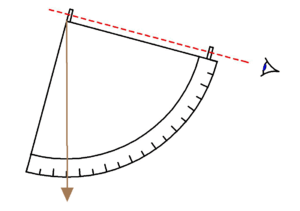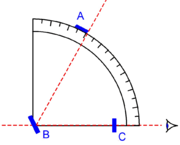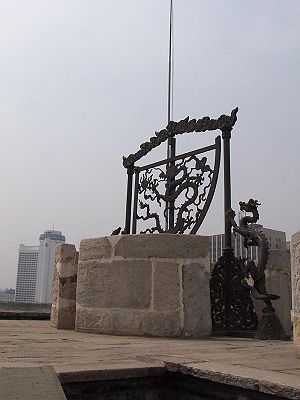.gif)
Quadrant (instrument)
Encyclopedia
A quadrant is an instrument that is used to measure angles up to 90°. It was originally proposed by Ptolemy
as a better kind of astrolabe
. Several different variations of the instrument were later produced by medieval Muslim astronomers.
They can also be classified as
 The geometric quadrant is a quarter-circle panel usually of wood or brass. Markings on the surface might be printed on paper and pasted to the wood or painted directly on the surface. Brass instruments had their markings scribed directly into the brass.
The geometric quadrant is a quarter-circle panel usually of wood or brass. Markings on the surface might be printed on paper and pasted to the wood or painted directly on the surface. Brass instruments had their markings scribed directly into the brass.
For marine navigation, the earliest examples were found around 1460. They were not graduated
in degrees but rather had the latitude
s of the most common destinations directly scribed on the limb. When in use, the navigator would sail north or south until the quadrant indicated he was at the destination's latitude, turn in the direction of the destination and sail to the destination maintaining a course of constant latitude. After 1480, more of the instruments were made with limbs graduated in degrees.
Along one edge there were two sights forming an alidade. A plumb bob was suspended by a line from the centre of the arc at the top.
In order to measure the altitude of a star, the observer would view the star through the sights and hold the quadrant so that the plane of the instrument was vertical. The plumb bob was allowed to hang vertical and the line indicated the reading on the arc's graduation
s. It was not uncommon for a second person to take the reading while the first concentrated on observing and holding the instrument in proper position.
The accuracy of the instrument was limited by its size and by the effect the wind or observer's motion would have on the plumb bob. For navigators on the deck of a moving ship, these limitations could be difficult to overcome.
 In order to avoid staring into the sun to measure its altitude, navigators could hold the instrument in front of them with the sun to their side. By having the sunward sighting vane cast its shadow on the lower sighting vane, it was possible to align the instrument to the sun. Care would have to be taken to ensure that the altitude of the centre of the sun was determined. This could be done by averaging the elevations of the upper and lower umbra
In order to avoid staring into the sun to measure its altitude, navigators could hold the instrument in front of them with the sun to their side. By having the sunward sighting vane cast its shadow on the lower sighting vane, it was possible to align the instrument to the sun. Care would have to be taken to ensure that the altitude of the centre of the sun was determined. This could be done by averaging the elevations of the upper and lower umbra
in the shadow.
With such a quadrant, the observer viewed the horizon from a sight vane (C in the figure on the right) through a slit in the horizon vane (B). This ensured the instrument was level. The observer moved the shadow vane (A) to a position on the graduated scale so as to cause its shadow to appear coincident with the level of the horizon on the horizon vane. This angle was the elevation of the sun.
 Large frame quadrants were used for astronomical measurements, notably determining the altitude of celestial
Large frame quadrants were used for astronomical measurements, notably determining the altitude of celestial
objects. They could be permanent installations, such as mural quadrant
s. Smaller quadrants could be moved. Like the similar astronomical sextants, they could be used in a vertical plane or made adjustable for any plane.
When set on a pedestal
or other mount, they could be used to measure the angular distance between any two celestial objects.
The details on their construction and use are essentially the same as those of the astronomical sextants; refer to that article for details.
Ptolemy
Claudius Ptolemy , was a Roman citizen of Egypt who wrote in Greek. He was a mathematician, astronomer, geographer, astrologer, and poet of a single epigram in the Greek Anthology. He lived in Egypt under Roman rule, and is believed to have been born in the town of Ptolemais Hermiou in the...
as a better kind of astrolabe
Astrolabe
An astrolabe is an elaborate inclinometer, historically used by astronomers, navigators, and astrologers. Its many uses include locating and predicting the positions of the Sun, Moon, planets, and stars, determining local time given local latitude and longitude, surveying, triangulation, and to...
. Several different variations of the instrument were later produced by medieval Muslim astronomers.
Types of quadrants
There are several types of quadrants:- Mural quadrantMural instrumentA mural instrument is an angle measuring device mounted on or built into a wall. For astronomical purposes, these walls were oriented so they lie precisely on a meridian. A mural instrument that measured angles from 0 to 90 degrees was called a mural quadrant.-Construction:Many older mural...
s used for measuring the altitudes of astronomical objects. - Large frame-based instruments used for measuring angular distances between astronomical objects.
- Geometric quadrant used by surveyorSurveyingSee Also: Public Land Survey SystemSurveying or land surveying is the technique, profession, and science of accurately determining the terrestrial or three-dimensional position of points and the distances and angles between them...
s and navigatorNavigationNavigation is the process of monitoring and controlling the movement of a craft or vehicle from one place to another. It is also the term of art used for the specialized knowledge used by navigators to perform navigation tasks...
s. - Davis quadrant a compact, framed instrument used by navigators for measuring the altitudeAltitudeAltitude or height is defined based on the context in which it is used . As a general definition, altitude is a distance measurement, usually in the vertical or "up" direction, between a reference datum and a point or object. The reference datum also often varies according to the context...
of an astronomical object.
They can also be classified as
- Altitude - The plain quadrant with plumb line, used to take the altitudeAltitudeAltitude or height is defined based on the context in which it is used . As a general definition, altitude is a distance measurement, usually in the vertical or "up" direction, between a reference datum and a point or object. The reference datum also often varies according to the context...
of an object. - Gunner's - The quadrant used by an artillery officerArtilleryOriginally applied to any group of infantry primarily armed with projectile weapons, artillery has over time become limited in meaning to refer only to those engines of war that operate by projection of munitions far beyond the range of effect of personal weapons...
to set the angle of a gun barrel. - Gunter's - A quadrant used for time determination. Invented by Edmund GunterEdmund GunterEdmund Gunter , English mathematician, of Welsh descent, was born in Hertfordshire in 1581.He was educated at Westminster School, and in 1599 was elected a student of Christ Church, Oxford. He took orders, became a preacher in 1614, and in 1615 proceeded to the degree of bachelor in divinity...
in 1623. - Islamic - King identified four types of quadrants that were produced by Muslim astronomers.
- The sine quadrant (Arabic: Rubul Mujayyab) - also known as the "Sinecal Quadrant" – was used for solving trigonometric problems and taking astronomical observations. It was developed by al-Khwarizmi in 9th century Baghdad and prevalent until the nineteenth century. Its defining feature is a graph-paper like grid on one side that is divided into sixty equal intervals on each axis and is also bounded by a 90 degree graduated arc. A cord was attached to the apex of the quadrant with a bead at the end of it to act as a plumb bob. They were also sometimes drawn on the back of astrolabes.
- The universal (shakkāzīya) quadrant – used for solving astronomical problems for any latitude: These quadrants had either one or two sets of shakkāzīya grids and were developed in the fourteenth century in Syria. Some astrolabes are also printed on the back with the universal quadrant like an astrolabe created by Ibn al-Sarrāj.
- The horary quadrant – used for finding the time with the sun: The horary quadrant could be used to find the time either in equal or unequal (length of the day divided by twelve) hours. Different sets of markings were created for either equal or unequal hours. For measuring the time in equal hours, the horary quadrant could only be used for one specific latitude while a quadrant for unequal hours could be used anywhere based on an approximate formula. One edge of the quadrant had to be aligned with the sun, and once aligned, a bead on the end of a plumbline attached to the centre of the quadrant showed the time of the day. An example exists dated 1396, from European sources (Richard IIRichard II-People:*Richard II of England , King of England.*Richard II of Normandy , Duke of Normandy*Richard II of Aquila *Richard II of Capua *A nickname for Richard M...
of England). - The astrolabe/almucantarAlmucantarAn Almucantar, also spelled almucantarat or almacantara, is a circle on the celestial sphere parallel to the horizon. Two stars that lie the same almucantar have the same altitude.-Almucantar staff:...
quadrant – a quadrant developed from the astrolabe: This quadrant was marked with one half of a typical astrolabe plate as astrolabe plates are symmetrical. A cord attached from the centre of the quadrant with a bead at the other end was moved to represent the position of a celestial body (sun or a star). The ecliptic and star positions were marked on the quadrant for the above. It is not known where and when the astrolabe quadrant was invented, existent astrolabe quadrants are either of Ottoman or Mamluk origin, while there have been discovered twelfth century Egyptian and fourteenth century Syrian treatises on the astrolabe quadrant. These quadrants proved to be very popular alternatives to astrolabes.
The Geometric Quadrant

For marine navigation, the earliest examples were found around 1460. They were not graduated
Graduation (instrument)
-Linear graduation:Linear graduation of a scale occurs on a straight instrument. The graduation can identify linear measures, such as inches or millimetres on a rule. They can also be non-linear such as logarithmic or other transcendental scales....
in degrees but rather had the latitude
Latitude
In geography, the latitude of a location on the Earth is the angular distance of that location south or north of the Equator. The latitude is an angle, and is usually measured in degrees . The equator has a latitude of 0°, the North pole has a latitude of 90° north , and the South pole has a...
s of the most common destinations directly scribed on the limb. When in use, the navigator would sail north or south until the quadrant indicated he was at the destination's latitude, turn in the direction of the destination and sail to the destination maintaining a course of constant latitude. After 1480, more of the instruments were made with limbs graduated in degrees.
Along one edge there were two sights forming an alidade. A plumb bob was suspended by a line from the centre of the arc at the top.
In order to measure the altitude of a star, the observer would view the star through the sights and hold the quadrant so that the plane of the instrument was vertical. The plumb bob was allowed to hang vertical and the line indicated the reading on the arc's graduation
Graduation (instrument)
-Linear graduation:Linear graduation of a scale occurs on a straight instrument. The graduation can identify linear measures, such as inches or millimetres on a rule. They can also be non-linear such as logarithmic or other transcendental scales....
s. It was not uncommon for a second person to take the reading while the first concentrated on observing and holding the instrument in proper position.
The accuracy of the instrument was limited by its size and by the effect the wind or observer's motion would have on the plumb bob. For navigators on the deck of a moving ship, these limitations could be difficult to overcome.
Solar observations

Umbra
The umbra, penumbra and antumbra are the names given to three distinct parts of a shadow, created by any light source. For a point source only the umbra is cast.These names are most often used to refer to the shadows cast by celestial bodies....
in the shadow.
Back observation quadrant
In order to perform measurements of the altitude of the sun, a back observation quadrant was developed.With such a quadrant, the observer viewed the horizon from a sight vane (C in the figure on the right) through a slit in the horizon vane (B). This ensured the instrument was level. The observer moved the shadow vane (A) to a position on the graduated scale so as to cause its shadow to appear coincident with the level of the horizon on the horizon vane. This angle was the elevation of the sun.
Framed quadrant

Celestial
- Science :* Sky objects, bodies and the following astronomy terms:** Astronomical objects, see for detailed description of celestial bodies and objects** Celestia, a 3D astronomy program that allows users to travel through the universe...
objects. They could be permanent installations, such as mural quadrant
Mural instrument
A mural instrument is an angle measuring device mounted on or built into a wall. For astronomical purposes, these walls were oriented so they lie precisely on a meridian. A mural instrument that measured angles from 0 to 90 degrees was called a mural quadrant.-Construction:Many older mural...
s. Smaller quadrants could be moved. Like the similar astronomical sextants, they could be used in a vertical plane or made adjustable for any plane.
When set on a pedestal
Pedestal
Pedestal is a term generally applied to the support of a statue or a vase....
or other mount, they could be used to measure the angular distance between any two celestial objects.
The details on their construction and use are essentially the same as those of the astronomical sextants; refer to that article for details.
External links
- A working quadrant in coin form
- Richard IIRichard II-People:*Richard II of England , King of England.*Richard II of Normandy , Duke of Normandy*Richard II of Aquila *Richard II of Capua *A nickname for Richard M...
(1396) era equal hour horary quadrant (pictures):

